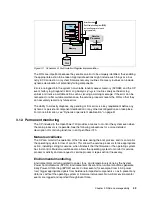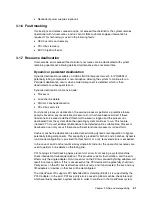
56
OpenPower 720 Technical Overview and Introduction
several OpenPower systems that are part of the cluster. If a OpenPower 720 is configured in
partition mode (with physical or virtual resources) is part of the cluster, all partitions must be
part of the cluster. (Check with your IBM support representative for the availability of this
feature).
It is not possible to use selected partitions as part of the cluster and use others for non-cluster
use. The HMC uses a dedicated connection to the OpenPower 720 to provide the functions
needed to control the server, such as powering the system on and off. The HMC must have
an Ethernet connection to the Control Work Station (CWS). Each partition in an OpenPower
720 must have an Ethernet adapter to connect to the CWS
trusted
LAN.
Information regarding HMC control, cluster building block servers, and cluster software
available at:
http://www.ibm.com/servers/eserver/clusters/
The benefits of a clustered environment based on logical partitions
The evolution of processor and storage technologies has a great impact on the architecture of
IT infrastructures. This is the most significant challenge for the infrastructure. During the first
half of the 1990s, one single central instance of an application per node was suitable,
moreover, most productive systems needed additionally associated nodes, so-called
application servers.
Increasing performance and reliability by simply replicating application server nodes led to
complex environments that often resulted in poor system management. The reason for these
complex constructions was the limited computing power of a single node. This limitation was
softened during the second half of the 1990s.
Large symmetric multiprocessor (SMP) nodes with higher clock rates and increased memory
provided the possibility to install more than one system on a node. More systems made
release planning more difficult as operations had to pay attention to different databases or
application versions to avoid unresolved conflicts.
Some customers expanded the usage of their dedicated systems and consequently model
more business processes. This often caused an increased number of dedicated systems
used and a stronger demand on flexibility. In addition, the life cycle of these systems differed
extremely. Renaming, removal, or deletion became more and more common system
administration tasks.
In 2001, the pSeries hardware technology with logical partitioning was generally available.
Logical partitioning provides the ability to define the logical partitions (LPARs) that are
adapted to customer needs regarding the number of processors, assigned memory, and I/O
adapters. The OpenPower 720 offers the flexibility to increase the usage of the resources
even more using Micro-Partitioning technology, and reduce the total cost of ownership (TCO).
Partitions with associated physical resources or virtual resources are not different from a
collection of stand-alone nodes.
Today, server consolidation is a must for many IT sites. Minimized TCO and complexity, with
the maximum amount of flexibility, is a crucial goal of nearly all customers. LPARs allow a
flexible distribution of resources with LPAR boundaries. Each logical partition can be
configured according to the specific needs of the occupant application. LPARs provide a
protection boundary between the systems. More test and development systems can exist on
the same server in separate partitions.
Содержание OpenPower 720
Страница 2: ......
Страница 28: ...18 OpenPower 720 Technical Overview and Introduction...
Страница 68: ...58 OpenPower 720 Technical Overview and Introduction...
Страница 72: ...62 OpenPower 720 Technical Overview and Introduction...
Страница 73: ......









































